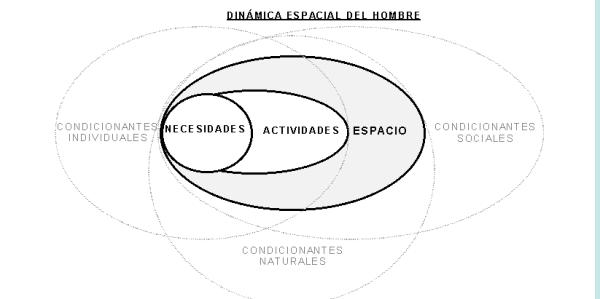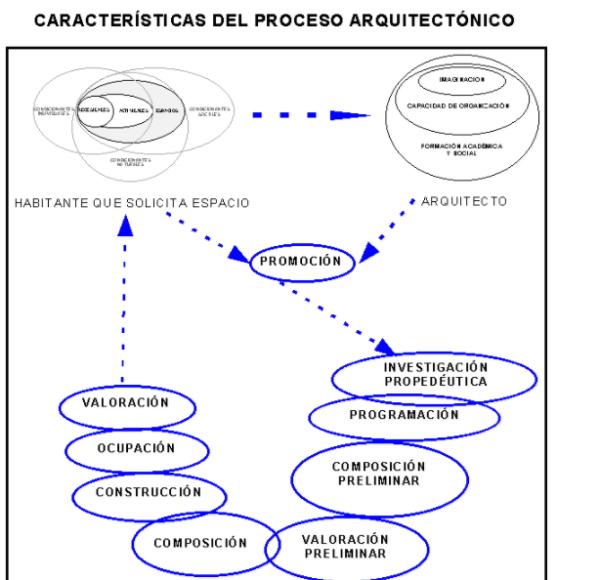
This exhibition aims to highlight the importance of psychosocial analysis in architecture.
Psychosocial analysis stands out because, according to the elements from which it is based, there are different ways of understanding architectural work. Bioclimatism, for example, imposes a way of reasoning about architecture; The construction system forces other types of conclusions or geometry, or styles, but it is not about these fields that we want to reason about, it is about the psychosocial.
In this PsychologyOnline article, we will discuss Psychosocial analysis in architecture.
Incorporation of the psychosocial in architecture
When addressing the psychosocial problem as an element to consider In architectural composition it seems obvious what we are talking about and there is practically a general agreement on the importance of the topic, even though in reality it is not easy to find an answer to the question of:
How do you incorporate the psychosocial into the project?
At first glance the problem is solved by talking to the inhabitant, but what do we need to know about him?
Your age, sex, income, marital status, are these data enough to project a space?
How important are a person’s personality traits or class status?
From a human perspective, the importance of these approaches is undeniable but it must be noted that psychosocial analysis is a different activity from architecture and that the results of this type of analysis are not architectural work. This becomes evident when, after carrying out extensive demographic, economic, or psychological research, the architect decides to save all the data and takes the blank page to start his work.
Possibly it is because of this circumstance that many architects consider it useless to develop an entire investigation and consider it sufficient to be guided by their humanism, achieving success but without establishing the social technique with which they worked.
The problem then still exists.
How to do research that gives clear indications about the content social that architectural spaces should have?
To explain this position it is convenient to reflect on man and space, on the conditions that a place requires for it to be inhabited, on its habitability.
When thinking about the relationship between man and space, you will realize that the human being cannot be conceived without locating him in a place, which does not mean that this “being” corresponds to a simple “being.”
Being in a place does not have the same meaning as putting your shoes under the bed. The human being is not an inert object, he is a living and creative being, so occupying a place does not only mean that the man is there. , also raises his projection as an individual and as a social entity.
From this conception, space is presented as the basic existential condition of man; it is unavoidable to find a place to develop activities with which to satisfy needs and express oneself as a person.
Approach
Heidegger in the essay I titled, “Thinking to Dwell and Build” states that it is commonly believed that buildings are constructed as the main and first part of the habitation and points out the error of this conception since the principle is found in the man who needs inhabit and that is why the building is built.
Needs are demands that need to be satisfied so that the individual can develop his or her activities and potentialities; These are an impulse that generates activity. Activity that due to existential condition must be carried out in a space. Space that initially represents a natural space but to the extent that an intentional activity is developed, they begin to form part of the architectural space.
The fact of “occupying” space, of finding the place to reside, is called inhabiting, so that man only realizes himself as such by inhabiting space, it cannot be any other way. To inhabit means, from this perspective, find the place to solve the needs. Imagine any: study, coexistence, intimacy, love; An image, a person, an object, a situation immediately arises within the mind, which will be irremediably linked to a place.
The architect commonly starts from a demand, that is, from the open manifestation of a need. But this is where the problem of architectural logic begins. The architect only starts from the demand for the space, he does not know what content the space requires, and in this situation he allows himself to be guided by stereotypes and “intuitions” that replace the feelings of the inhabitants themselves and divert the content of the spaces. towards what they believe is most convenient. He assumes that he knows what space he requires. He does what he believes even if it has no foundation.
To avoid this deviation of the content of the architectural work and for the spaces to project the solution to the needs of individuals and society, there is a need to know what content the inhabitant himself gives to the spaces. That is, the need arises for carry out research prior to the project, about what are the needs of the inhabitants like? How do they carry out the activities with which they solve these needs? What are the spaces they use like? That is, a psychosocial assessment of habitability is required. Task that the Architect José Villagrán García called Architectural Propedeutics.
When carrying out this propaedeutic, even when searching for the content of space, at no time is it expected that the result of the work will be a line, nor is it even attempted to pose the problem of composition, what is suggested is a method in which that the architect makes the inhabitant’s experience of the space his own and develops an adequate architectural program, which, as Maestro Villagrán pointed out, must contain the set of demands and requirements of the construction.

The role of the architect
To generate in the architect the experience that the inhabitants have of the space, it must be taken into account that this fact is not mechanical, It is not the simple biophysical phenomenon of stimulus response, nor is it feasible to find models that universally explain man’s reactions to space. Although it is possible to identify certain constants in terms of auditory, visual or tactile capacity and constants can even be found in terms of the type of needs that motivate the activity of individuals and society, despite all this, the human being is a being. changing. This fact is what allows cultural diversity and raises the right to identity.
Thus, each circumstance will require the architect to understand the ways of inhabiting the space, observing that the architect himself is not oblivious to his psychosocial condition; he also modifies what he sees based on his own motivations, his own needs. However, to the extent that through the indicated propaedeutics you identify the traits of the culture, society, and personality of those who demand the space, you will have the support of this data to base your decisions, it will not simply be guided by chance the one who achieves a successful work; Even though it should be noted that, even when there is no explicit training to grasp the culture of the environment, there will be those who, due to its sensitivity, achieve it.
The psychosocial analysis proposal presented here, consists of the architect managing the user’s experience in himself and formulating a program that indicates the content that the spaces need to have according to the spatial experience of the inhabitant himself. The architect’s job will be to translate these experiences into forms that have useful, firm, didactic, aesthetic and symbolic content.
So then the architect, already from the elaboration of the program itself, puts his imagination to work, makes a prefiguration of what space will contain. Conceive a film of what the building could be like and what will happen in it, restricting itself to the characteristics of the characters, the inhabitants.
In this work of prefiguration, from the psychosocial perspective that is proposed, the architectural space will be composed not only of the volume, of the container of activities, but also of the objects, colors, furniture, and interiors of that space. .
This concern for interiors is not a problem of decoration, it is the problem of providing individuals with the space they require to satisfy their needs. Needs that are not only biological or primary in nature. Man is a complex being that requires self-realization, identity, and projection, and these situations are not considered. Man is treated as an object that measures 70 cm when sitting or 1.80 when standing, without considering their existential needs.
The problem is that the architect takes into account the different conditions in which an individual finds himself, identifies the needs of the inhabitants of a space and the way they have to resolve them. So then the forms that he proposes and builds will be spaces that promote and strengthen man’s way of living.
Proposing respect for people’s way of life does not mean that a rigid or static society is promoted, it does not seek to continue with houses with dirt floors and open defecation, but rather to understand what they are like? and from these data project.
Commonly within the professional field it is insisted on the importance of being innovative And it should be noted that the innovator is the one who understands the goals of a society and finds new ways to reach them. That is the challenge!
In this case the goal is to create spaces that promote the solution of the integral needs of man and, despite the different economic and political limitations, this will depend on the way of understanding what man is like, how he carries out activities, what he satisfies. their needs, how they relate to the space.
On the other hand, it must be observed that in this gestation of the program and prefiguration of the spaces, the architect develops a logic different from how any other science does since, when knowing the needs is mentioned, an explanation of why is not sought. , nor develop a theory of what man is, this is knowledge specific to sociology, psychology or anthropology, knowledge that is acquired and used by the architect, but is not developed by him, its logical problem is another. , is to present a proposal, a hypothesis that, as identified by Margarit and Buxade, has a hypothetical experimental character.

What does the hypothetical experimental work of the architect consist of?
It consists of make a projectiona prefiguration of what space can be. A hypothesis, but not an explanatory hypothesis, but a hypothesis of a solution or alternative to the form that a space could have for man to solve his needs. That is, a type of knowledge that requires being subject to experimentation, that needs to be built and inhabited so that the hypothesis is confirmed.
In this prefiguration work, the composition begins and, through analysis and synthesis, different tests are mentally carried out in which the image that is created is contrasted against the different conditions that the spatial problem has to solve, until the best content is found. of the form. Afterwards, the space is built and the cycle is closed at the moment in which the compositional proposal is verified with the experience of the inhabitant.
During this cycle, psychosocial work intervenes only at two specific moments. First of all, at the time of program development during the propaedeutic phase, but later, in the compositional task All research is left aside and the spatial problem is approached with other logics, that of geometry, that of materials, that of costs, that of techniques, and it is not until the moment that the inhabitant occupies the space. in which psychosocial work once again has an influence in the analysis.
In this second participation, which North Americans call Post-Occupational Evaluation, the needs are analyzed again and it is observed whether the spaces really satisfy them, thus developing two phases of knowledge. At first, the architect develops a hypothesis with <> knowledge and, when evaluating the final work, there is <> knowledge that can revitalize the architectural cycle if the architect is able to become aware of the benefits this can offer you.
It should be noted that the needs are complex, they are not solved in their entirety simply with a “good construction”, they require expressive elements that go beyond the technique and the minimum of well-being, which are found only in the psychosocial context in which occur, the problem is being able to observe them.
That is the situation that the student faces when, after making a field visit, he is asked about the architectural features of the town he visited and answers that he didn’t see anything! For him the place is like an empty space. He is so used to his schemes, to standardized spaces that he only imagines a meeting place if it is in a room, but if people sit in the shade of a tree or on a porch it has no meaning.
The problem will then be to train them to see the relationship between needs and spaces beyond an “architectural typology”.
Finally, it must be noted that unfortunately the system is alienating, well-being is sacrificed for consumerism, fashions prevail and, instead of seeking alternative solutions, business models are strengthened day by day.
Surely for mass construction investors these reflections are useless. However, the social consequences that are suffered politically and psychologically at the expense of economic benefit cannot be sustained indefinitely; it is necessary that economic policies observe that a benefit in the quality of life of the population will achieve not only the benefit of individuals, but also that of society, including investors.
To the extent that spaces offer greater potential, this will result in greater general performance of the individual, society and the environment.
Conclusions
In reality the cost of this type of work is low, it only requires carrying out psychosocial assessments, architectural propaedeutics that strengthen the programs, put aside the vision of the architect as a technician alien to his world and recover his humanistic vision.
It is essential that architecture returns to its originsthe satisfaction of man, only by producing operational schemes that convince society of the validity and usefulness of the profession will the identity of architecture be recovered, otherwise the possibility of producing well-being, of generating a feeling of satisfaction, will continue to be an exclusive field for the privileged who have beauty as an indicator of prestige and power.
This article is merely informative, at PsychologyFor we do not have the power to make a diagnosis or recommend a treatment. We invite you to go to a psychologist to treat your particular case.
If you want to read more articles similar to Psychosocial analysis in architecture we recommend that you enter our Social Psychology category.








